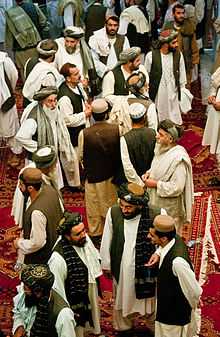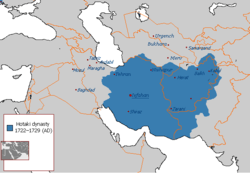Pashtun tribes
- This articles is about the tribal lineages. For tribal structure see Pashtun tribal structure.
 |
| Part of a series on |
| Pashtuns |
|---|
| Kingdoms |
| Religion |
The Pashtun tribes (Pashto: پښتانه ټبرونه) form the world's largest tribal society.[1] The Pashtun people are traditionally divided into four tribal confederacies: the Sarbani (سربڼي), the Bettani (بېټني), the Ghurghakhti (غرغښتي), and the Karlani (کرلاڼي).
Folkloric genealogies trace the descent of the Pashtuns to Qais Abdur Rashid and his three sons Sarbaṇ (سربڼ), Beṭ (بېټ), and Ghurghax̌t (غرغښت). Qais is also said to had a fourth adopted son, Orməṛ (اورمړ), who became the progenitor of the Karlani confederacy.[2]:33 Estimates of the number of Pashtun tribes and clans range from about 350 to over 400.[3][4]
Bettani
The Bettani confederacy include the Bettani proper (whose highest concentration is in the region around Jandola), the much larger Ghilji and Lodi tribal groups, and Shirani and other minor tribes.
Dialects
The Bettani speak various Pashto dialects. The Ghilji of the central region around Ghazni speak Central Pashto, a dialect with unique phonetic features, transitional between the southern and the northern dialects of Pashto.[2] The Marwat, as well as some other minor Lodi tribes and the Bettani proper, speak the Marwat–Lodi–Bettani dialect, which is a southern Pashto variety, however, its phonetics are different from the southern Kandahari Pashto. The Shirani tribe of the Bettani confederacy speaks another southern dialect. The northern Bettani clans speak the northern or "hard" Pashto variety.
Some of the Bettani lineages, including some (but not all) clans of the Niazi, Tanoli, and Swati tribes, have abandoned Pashto. Today they speak other languages, like Hindko, Saraiki, Punjabi, and Dari.
History
One theory suggests that the modern Ghilji lineages descended from the medieval Khalaj or Khilji tribe. Some Bettani lineages, however, are said to have descended in part from the medieval Ghorid people.
The Bettani are named after their folkloric leader or ancestor, Shaykh Beṭ Nīkə (claimed to be among the first Pashto-language poets), who lived in the Altamur range, located between the Logar and Zurmat valleys. He is reported to have been buried in Ghazni.[5]
In the 15th century, the Bettani are known to have mainly inhabited the Logar, Zurmat, and Ghazni regions.[5] Subsequently, many of their lineages settled to the northeast, spreading up to the Damaan Valley, Mianwali, and parts of the present-day Hazara region of Khyber Pakhtunkhwa in the east, and parts of Kunduz in the north. In the 19th century, the traditional way of life of the Bettani combined small-scale irrigated agriculture with seasonal nomadism or seminomadism. They engaged in pastoral migrations, along the mountain slopes in summers, and inversely, towards the Indus plains in winters.[5]
Dynasties
From the 13th century, various Khilji dynasties and ruling entities took control in the Bengal and Delhi Sultanates of the Indian subcontinent. In the 15th century, the Lodi tribe founded the Lodi dynasty, the last dynasty to rule the Delhi Sultanate. In the 16th century, the Sur Empire with its capital at Delhi was founded by Sher Shah Suri, a member of the Sur clan of the Bettani confederacy. Between 1709 and 1738, the Hotak clan of the Ghilji tribe ruled the Hotak Empire based first in Kandahar, Afghanistan and later very briefly in Isfahan, Persia.[6]
Tribes and clans
The Bettani confederacy include:[7]
- Bettani
- Stanikzai
- Swati
Ghurghakhti
Among the major Ghurghakhti (or Ghurghashti) tribes are the Kakar, settled mainly in the Balochistan province of Pakistan and the Kandahar, Zabul, and Herat provinces of Afghanistan; the Jadun, settled mainly in Khyber Pakhtunkhwa in Pakistan; and the Safi, whose highest concentration is in the Kohi Safi district of Parwan province and the Pech valley of Kunar province, but are also present in other parts of northeastern Afghanistan and in northwestern Pakistan. There are also other minor Ghurghakhti tribes.
Dialects
The Kakar and other minor Ghurghakhti tribes settled in the region around Quetta speak the Kakar dialect, which is a southern or "soft" Pashto dialect very similar to Kandahari Pashto. The Safi, some of the Jaduns, and some other minor northern tribes speak the northern or "hard" Pashto variety.
Many of the Jaduns, however, have abandoned Pashto; now they speak Hindko.[2]:26 Some clans of the Safi tribe speak the Pashayi languages but are mostly bilingual in Pashto.
Tribes and clans
The Ghurghakhti confederacy include:
- Mashwani
Karlani

The Karlani confederacy primarily inhabit the eastern, northeastern, and central regions of Loya Paktia, and the southwestern region of Nangarhar in Afghanistan; as well as the southern and central regions of the Federally Administered Tribal Areas and Khyber Pakhtunkhwa in Pakistan.
Dialects
The Karlani speak some of the most distinctive Pashto dialects which are lexically different from standard Pashto varieties, and phonetically very varied. Furthermore, the Karlani dialects have a tendency towards a change in the pronunciation of vowels. Depending on the particular dialect, the standard Pashto [a], [ā], [o], [u] may change into [ā], [â/å/o], [ȯ/ȫ/e], [i], respectively.[8] In the Karlani dialects of Waziristan, Bannu, and Tani (southern Khost), which follow the vowel shift to the greatest extent, these four vowels normally change into [ā], [o], [e], [i], respectively.
Much of the Ormur tribe settled in some villages of Waziristan and Logar, who give their name to Orməṛ (the folkloric ancestor of all Karlani), speak the Ormuri language which is separate from Pashto.[2]:33 However, in general the Ormur are bilingual in Pashto, particularly in the Karlani dialect of Wazirwola.
History

In the 16th century, Taj Khan Karrani of the Karlani tribe founded the Karrani dynasty, the last dynasty to rule the Bengal Sultanate.
Several Karlani clans served in the Mughal army. The Bhopal State, in the present-day Madhya Pradesh state of Central India, was founded in 1723 by Dost Mohammad Khan Mirazikhel. He was from the Orakzai clan of the Karlani tribe, and was a mercenary in the Mughal army.[9] After his death in 1728, his descendants, the Nawabs of Bhopal, continued ruling the state until Hamidullah Khan, the last sovereign nawab of the dynasty, officially acceded the state to India in 1949.[10]
Tribes and clans
Karlani tribes include:
- Rodbari
- Khostwal
- Shitak
- Banuchi (Banisi)
- Dawar
- Tani
- Zazi
Sarbani

The Sarbani confederacy include the Durrani (historically called Abdali; including its politically influential Sadozai and Barakzai clans), Yusufzai, Tareen, Mohmand, Ghoryakhel, Shinwari, Kasi, and other minor tribes.
Dialects
Southern Sarbani tribes, most notably the Durrani, speak Kandahari Pashto, a "soft" dialect of Pashto; while northeastern Sarbani tribes, most notably the Yusufzai, speak Yusufzai (Peshawari) Pashto, a "hard" dialect of Pashto. Both of them are considered prestige dialects.
In addition, a small section of the Tareen clan of the Sarbani living east of Quetta speak the distinctive Wanetsi (Tarino) dialect, which is, however, considered by some modern scholars to be distinctive enough to be classified a separate language from modern Pashto.[11]
History
The origin of the Sarbani might be connected with the Hephthalites (Ebodalo),[12]:242 who had a large nomadic confederation in the 5th-6th centuries CE, as well as with the Scythians,[13] whose languages are also known to be in the Eastern Iranian group along with Pashto. These groups were settled where most of Pashtuns live today.
Dynasties

Ahmad Shah Durrani of the Sadozai clan of the Abdali tribe (now known as "Durrani" after him) established the Durrani Empire in 1747 with its capital at Kandahar. Ahmad Shah adopted the title Durr-e Durrānī ("pearl of pearls" or "pearl of the age"), and the name of his tribe Abdali was changed to "Durrani" after him.[12]:242 Ahmad Shah is now regarded as the founder of the modern state of Afghanistan. He controlled areas from Khorasan in the west up to Kashmir and Delhi in the east, and from the Amu Darya in the north up to the Arabian Sea in the south. It was the second-greatest Muslim empire in the second half of the 18th century, surpassed in size only by the Ottoman Empire.[14]
In 1826, Dost Mohammad Khan, of the Barakzai clan of the Durrani tribe, founded the Barakzai dynasty centered at Kabul.[15] The Barakzai dynasty ruled present-day Afghanistan until 1973 when Mohammed Zahir Shah, the last Barakzai king, was overthrown in a bloodless coup by his own cousin Mohammed Daoud Khan. The coup ended the Barakzai kingdom and established the Republic of Afghanistan (1973–1978).[16] The current heir apparent and crown prince of the Barakzai kingdom (23 July 2007 – present) is Ahmad Shah Khan.
Tribes and clans
There are 105[17] Sarbani tribes, including:
- Gigyani
- Yusufzai (Esapzai)[18]
- Ado Khel
- Babozai
- Kamalzai
- Mahabat Khel
- Mandanr
- Aba Khel
- Khadarzai (Khizarzai)
- Mahmudzai
- Manozai
- Razar
- Niamat Khel
- Ranizai
- Tahir Khel
- Yusuf (Esap)
- Oryakhel
See also
References
- ↑ Glatzer, Bernt (2002). "The Pashtun Tribal System" (PDF). New Delhi: Concept Publishers. Retrieved 25 January 2015.
- ↑ 2.0 2.1 2.2 2.3 Coyle, Dennis Walter (August 2014). "Placing Wardak among Pashto varieties" (PDF). University of North Dakota:UND. Retrieved 26 December 2014.
- ↑ Romano, Amy (2003). A Historical Atlas of Afghanistan. The Rosen Publishing Group. p. 28. ISBN 0-8239-3863-8. Retrieved 2010-10-17.
- ↑ Syed Saleem Shahzad (October 20, 2006). "Profiles of Pakistan's Seven Tribal Agencies". Retrieved 22 April 2010.
- ↑ 5.0 5.1 5.2 Balland, Daniel. Encyclopaedia Iranica. BĒṬANĪ. Originally published on 15 December 1989.
- ↑ Ewans, Martin; Sir Martin Ewans (2002). Afghanistan: a short history of its people and politics. New York: Perennial. p. 30. ISBN 0060505087. Retrieved 2010-09-27.
- ↑ Robinson, J. A. (1935) "Powindah Bhittani" Notes on Nomad Tribes of Eastern Afghanistan Government of India Press, New Delhi, India, page 158, OCLC 70239499
- ↑ Morgenstierne, Georg (15 December 1983). "AFGHANISTAN vi. Paṧto". Encyclopædia Iranica. Retrieved 24 January 2015.
- ↑ Shaharyar M. Khan (2000). The Begums of Bhopal: A History of the Princely State of Bhopal. I.B.Tauris. p. 119. ISBN 978-1-86064-528-0.
- ↑ S.R. Bakshi and O.P. Ralhan (2007). Madhya Pradesh Through the Ages. Sarup & Sons. p. 360. ISBN 978-81-7625-806-7.
- ↑ Hallberg, Daniel G. 1992. Pashto, Waneci, Ormuri. Sociolinguistic Survey of Northern Pakistan, 4. LINK
- ↑ 12.0 12.1 The Hephthalites: Archaeological and Historical Analysis, Aydogdu Kurbanov, Berlin, 2010, page 242.
- ↑ A brief history of Afghanistan, Shaista Wahab, Barry Youngerman, Infobase Publishing, 2007, page 14.
- ↑ "The Durrani dynasty". Louis Dupree, Nancy Hatch Dupree and others. Encyclopædia Britannica Online. 2010.
- ↑ Tarzi, Amin H. "DŌSTMOḤAMMAD KHAN". Encyclopædia Iranica (Online Edition ed.). United States: Columbia University.
- ↑ Rubin, Barnett. "DĀWŪD KHAN". In Ehsan Yarshater. Encyclopædia Iranica. Retrieved January 2015.
- ↑ "PashtunFoundation.org". En.pashtunfoundation.org. Retrieved 2012-06-20.
- ↑ Khan, Roshan (1986). Yūsufzaʼī qaum kī sarguzasht. Karachi: Roshan Khan and Company.
External links
- Pashtun Tribe, Clan, & Ethnic Genealogies, US Naval Postgraduate School
- Articulation of Tribalism into Modernity: the Case of Pashtuns in Afghanistan
